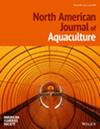紫外线不同程度地降低了鱼类和养鱼场相关黄杆菌(黄杆菌科和黄杆菌科)的生存能力。
IF 1.3
4区 农林科学
Q3 FISHERIES
引用次数: 0
摘要
摘要目的在全球范围内,黄杆菌(黄杆菌科和黄杆菌科)是导致养鱼场和孵化场疾病相关损失的主要原因。黄杆菌进入水产养殖设施的途径之一是通过水源。源水的紫外线(UV)处理在降低由非黄杆菌引起的疾病爆发的风险方面是有效的;然而,灭活黄杆菌所需的紫外线剂量尚未得到充分研究。本研究的主要目的是研究紫外光处理对降低浮游形式的鱼致病黄杆菌和鱼相关黄杆菌的生存能力的效果。方法在体外条件下,通过准直光束仪对黄杆菌属和黄杆菌属的65株黄杆菌进行低剂量(25 mJ/cm 2)和高剂量(126 mJ/cm 2)的紫外光照射,并通过培养测定其处理效果。结果在低剂量和高剂量的紫外照射下,所有黄杆菌的平均数量分别减少了~1000倍和~100,000倍;然而,在相同紫外线剂量下,在相同黄杆菌种类(包括嗜冷F.,柱状F.和oreochromis F.)的分离株中发现了实质性的差异。此外,在美国分布最广的嗜冷真菌多位点序列分型变异ST10和ST78对紫外线的敏感性最低。综上所示,25-126 mJ/ cm2的紫外线剂量可显著减少黄杆菌的存活,这表明该处理方法有望减少孵化场和水产养殖设施中黄杆菌的负荷,从而提高生物安全性,降低动物流行病的风险。本文章由计算机程序翻译,如有差异,请以英文原文为准。
Ultraviolet light differentially reduces viability of fish‐ and fish farm‐associated flavobacteria (families Flavobacteriaceae and Weeksellaceae)
Abstract Objective Globally, flavobacteria (family Flavobacteriaceae and Weeksellaceae) are leading causes of disease‐related losses in fish‐farms and hatcheries. One route flavobacteria gain access to aquaculture facilities is via source water. Ultraviolet (UV) light treatment of source water has been effective in reducing the risk of disease outbreaks caused by nonflavobacteria; however, the UV dose required to inactivate flavobacteria has been understudied. The primary objective of this study was to examine the efficacy of UV light treatments for reducing the viability of fish‐pathogenic and fish‐associated Flavobacterium and Chryseobacterium species in a planktonic form. Methods Sixty‐five flavobacterial isolates belonging to ten Flavobacterium spp. and Chryseobacterium spp. were exposed to a low (25 mJ/cm 2 ) and high (126 mJ/cm 2 ) dose of UV light via a collimating beam apparatus under in vitro conditions, after which treatment efficacy was determined via culture. Result All assayed flavobacteria were reduced by an average of ~1000‐fold or ~100,000‐fold at the low and high UV doses, respectively; however, substantial differences in reduction at the same UV dose were noted among isolates of the same flavobacterial species, including F. psychrophilum , F. columnare , and F. oreochromis . In addition, F. psychrophilum multilocus sequence typing variants ST10 and ST78, which are two of the most widespread variants in the United States of America, were among the least susceptible to ultraviolet light. Conclusion Overall, results demonstrate that viable flavobacteria can be reduced substantially by ultraviolet doses of 25–126 mJ/cm 2 , suggesting such treatments represent a promising tool for minimizing flavobacterial loads in hatcheries and aquaculture facilities, thereby enhancing biosecurity and reducing the risk of epizootics.
求助全文
通过发布文献求助,成功后即可免费获取论文全文。
去求助
来源期刊
CiteScore
2.50
自引率
0.00%
发文量
46
审稿时长
18-36 weeks
期刊介绍:
The North American Journal of Aquaculture publishes papers on new research and practical experience in all areas of intensive and extensive fish culture. Topics include broodstock selection and spawning, nutrition and feeding, health and water quality, facilities and production technology, and the management of ponds, pens, and raceways.
The journal will consider papers dealing with ways to improve the husbandry of any aquatic species—marine or freshwater, vertebrate or invertebrate—raised for commercial, scientific, recreational, enhancement, or restoration purposes that may be of interest to practitioners in North America. Its scope includes both basic and applied science, but applied scientific endeavors—including practical experiences, descriptive studies, and other nontraditional, but pertinent works—are emphasized.

 求助内容:
求助内容: 应助结果提醒方式:
应助结果提醒方式:


